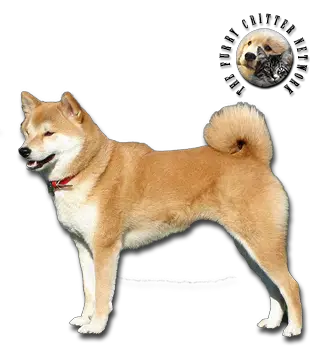Breed Standard
Head: Triangular, foxlike. Broad, flat skull and forehead. Distinct stop. Straight nose bridge. Wedge-shaped muzzle. Black nose (flesh color in whites). Tight lips.
Ears: Small, triangular. Held erect and slightly forward.
Eyes: Small, triangular, wide set. Dark brown color.
Body: Strongly constructed. Powerful neck without dewlap. Pronounced withers. Moderately wide loin. Prominent forechest. Deep chest. Belly is well tucked up. Straight, solid back.Nicely sloped croup.
Tail: Set high. Thick. Carried over the back, tightly curled or in the form of a sickle.
Hair: Short, harsh, straight. Slightly longer on the tail. Soft, compact undercoat.
Coat: Brindle (black, red, white, etc.). Black, red, or brown.
Size: 48.5 to 52 cm (19-20.5 in).Bitch: 45.5 to 48.5 cm (18-19 in).
Weight: Approx. 25 kg (55lb).
History
The Ainu originated in the mountainous regions of Hokkaido Island and was brought to Japan by the ancient Ainus. This hardy dog was used for hunting large game. The Ainu Dog is a Japanese Spitz breed rarely seen outside the country of Japan. The dog was named after the Ainu tribe. Origin is unknown. They arrived in Japan over 3,000 years ago when the Ainu brought this Spitz-type dog with them. As the Ainu were pushed onto the island of Hokkaido by an influx of Japanese people, their dogs gradually became restricted to this island. The dog's ever-alert and suspicious nature lent itself to the required role of village guardian. Their dog has changed little over the centuries. The Ainu Dog is probably the oldest of the Japanese breeds. It was later named the Hokkaido Dog, but is still better known as the Ainu Dog; indeed it is registered with the FCI under that name while it is known in the AKC as the Hokkaido Dog. Many Ainu Dogs have blue-black tongues, a physical trait that suggests a distant relationship with the similarly tongued Chow Chow and Shar Pei. Through the active work of the Society For The Preservation of Japanese Breeds, the Ainu Dog was designated a Japanese Natural Monument in 1937. The Ainu Dog has always distinguished itself in big-game hunting (especially bears), in guarding property, and as a draft animal.
Behavior
Brought up as a family pet, Ainu Dogs may deviate from the more primal temperament exhibited with dogs in hunting kennels. The Ainu Dog is highly intelligent and food motivated, a combination that results in positive responses to training. Hunting dogs are encouraged to be vocal, but an Ainu Dog as a family pet may not necessarily exhibit such habits with training. As the Ainu Dog has very little distribution throughout countries outside Japan, the Ainu Dog's temperament solely as a family pet is still forming. Although the Ainu Dog carries an innate prey drive, early socialization shows good behaviors with cats and other small animals considered to be part of its 'pack'.
The Ainu Dog's play is different from other breeds, with a more crouch and prowl style of play that is often misunderstood as aggression. For this reason, Ainu Dogs are often considered to be leash-only animals. However, with its roots to hunting, they have excellent owner stickiness and work well with recall techniques.
They are good with children and other animals if they are raised with them from puppyhood and/or properly socialized. The Ainu Dog needs moderate but regular exercise to stay in shape. It should be taken for long daily walks.
Function
Traditionally in Japan, the dog has been used as a working breed that plays both the role of family pet and hunter. In Japan, they are strongly tied to hunting kennels and work alongside their handlers to manage populations of wild boar and bear. Their vocal nature manifests in varying types of characteristic howls, long and short barks, used as sighting signals on hunts. They have an unusual fighting style against the Hokkaido brown bear, or higuma, and will take risks to protect its master, despite size differences. The way in which the Ainu dog accomplishes this is to attack the bear's back, then bite and hold the dorsal flesh of the bear's neck until the bear retreats. For this purpose, the Hokkaido in Japan are encouraged to have a fierce and unrelenting character that benefits in the field.
Health
The Ainu Dog has a very high rate of Collie eye anomaly (CEA). About 1/3 of Ainu Dogs are affected by CEA while 2/3 are carriers.






